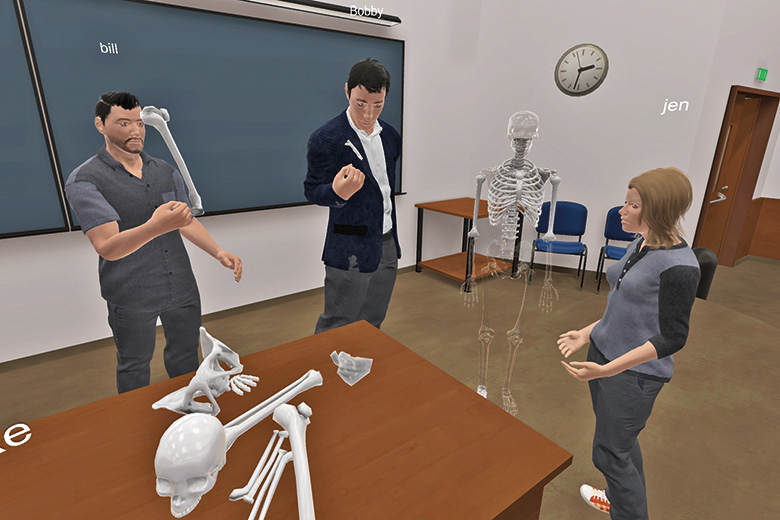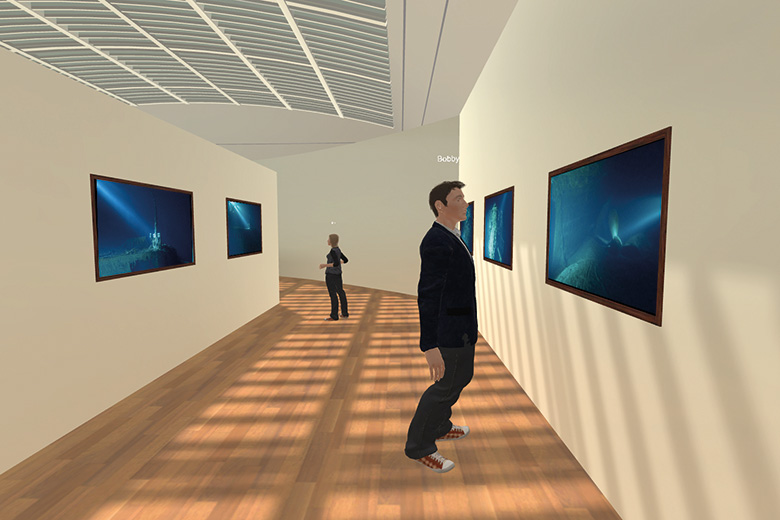I’m in a lecture hall listening to a cartoonish avatar of the American astrophysicist Neil deGrasse Tyson explain the history of science. Just as he starts speaking about medieval beliefs in demons, a red devil appears out of nowhere. It rushes at my face baring its teeth, making me flinch.
As Tyson moves on to Galileo and the experimental method, he conjures a model of the Leaning Tower of Pisa out of thin air, from which drop the two famous balls of different mass with exactly the same accelerations.
This lecture hall is, of course, not real. I’m wearing a virtual reality (VR) headset, experiencing the virtual spaces created by Immersive VR Education, a company based in a non-descript business park in the Republic of Ireland’s oldest city, Waterford. Tyson’s conjuring tricks are just a taste of VR’s potential to change how students learn, according to Dave Whelan, who quit his web design business to found the company in 2014 after donning a headset for the first time. (“As soon as I put it on my face, I knew I wanted to work in VR,” he says.)
Whelan envisages a world where aeronautics students assemble jet engines in VR, engineers build bridges around them using a kind of “virtual Meccano set” and chemistry lecturers take their classes inside models of molecules. “Why even teach in a classroom?” he asks. “If you’re teaching marine biology, teach that on the seabed and have a whale swim through the centre of the class. It’s a lot more engaging.”
Whelan is just one of many people experimenting with the educative potential of VR now that the technology is widely accessible. High-quality headsets that can smoothly track head movements have come on to the consumer market in the past year. You would struggle to mistake the alternative worlds they conjure for real life just yet, but developers are already creating impressively detailed environments that look nearly as good as current computer games.
At the top end, the headsets are not cheap, starting at £350 ($433) each and requiring a powerful computer, or a PlayStation 4, to run on (more affordable systems that do not track movement as comprehensively use smartphones that slot into relatively simple goggles). But despite the cost of equipping classrooms and lecture halls, education is predicted to become a sizeable part of the emerging VR market. A Goldman Sachs report released early last year predicted that there could be a $700 million (£550 million), 15 million-user market in schools and universities by 2025. And in October, Facebook, which bought headset maker Oculus for $2 billion in 2014, promised $10 million to help develop educational VR experiences.
Immersive VR Education is part of this push to extend the benefits of VR – which so far has been geared towards gaming – into education. The application that hosts the Tyson lecture is called Engage, which is in essence a customisable space in which academics can call up 3D models so that students can inspect them from every angle. (Whelan is set to demonstrate the system to the University of Oxford the week after I meet him.) In one demonstration, I assemble a human skeleton with one of Whelan’s colleagues. Although my partner is controlling his avatar from the next room, we can throw bones to each other before putting them together. Using the handheld controllers, I can pick up and examine the flattish bone that sits below the shoulder, turning it over and then slotting it into place. Even three weeks later, the memory of its shape is vivid (although I have forgotten what it is called). These virtual spaces “feel like real locations, and they’re making real memories”, says Whelan.
It is easy enough for a medical student to examine a human skeleton without virtual reality, of course. But Whelan says that the next stage of the project is to create a far more detailed model of human anatomy that can be disassembled and reconstructed in VR. “That’s going to be useful for all medical institutes,” he says, adding that medicine is the “beachhead” for the use of VR in universities.
Earlier this year, Case Western Reserve University in Cleveland, Ohio, released a video showing how it is using Microsoft’s HoloLens headset to teach its medical students (below).
Unlike the headsets that Whelan uses, the HoloLens allows users see the environment around them as it projects images on to a visor to create 3D objects that appear, hologram-like, in the room around them (this is known as augmented, or mixed, reality). At $3,000, the HoloLens is particularly expensive, but it is not aimed at consumers.
In the video, students wearing the headsets are shown inspecting a model of the human body from every angle. At one point they are even joined by the floating head of their lecturer (physically located in another city), who explains connections in the brain. Learning is so much faster that “students have commented that a 15-minute session with HoloLens could have saved them dozens of hours in the cadaveric lab”, says Pamela Davis, dean of Case Western Reserve’s medical school.

All these complex models, be they of parts of the human body, chemical compounds or the solar system, have to be created by somebody before they can be used in a VR classroom. But Whelan says that there are already thousands of educational 3D models in existence, and academics could request ones that do not yet exist from model creators, who could then charge for their work.
VR does not have to mimic the physical lecture room, as I discover in another of Immersive VR Education’s simulations. In this one, you stand on a jetty and, after being told how to calculate the flight of a cannonball through the air, do some sums on a virtual whiteboard to work out how to angle a cannon so that it hits a battleship off the shore. This is nothing that students couldn’t do on a computer screen, but playing with ballistics in VR feels far more absorbing (not least because you cannot check your mobile phone or get distracted by others in the room).
There are also less obvious applications for VR outside the physical sciences, such as in law. The University of Westminster has built a virtual space for criminal law students, in which they hunt for clues to construct a murder case. Rather than simply reading witness statements, they can walk around a building and judge whether someone would have been able to see the crime, explains Markos Mentzelopoulos, senior lecturer in computer science at Westminster.
The promise of this kind of interactive VR education, according to advocates such as Whelan, is that students remember far more of what they do in such lessons, compared with what they read, hear or see in a traditional lecture theatre. They base this assertion on an educational theory called the cone of learning, invented by the American educationalist Edgar Dale in the 1960s, which ranks types of learning by how much information retention it leads to.
But this simple hierarchy of experiences – according to which students are supposed to retain 10 per cent of what they read but 90 per cent of what they say or do – has been “widely criticised as an over-simplification of the complex process of learning”, argues Neil Morris, who has worked on virtual learning environments as director of digital learning at the University of Leeds.
Still, there is good research evidence that students remember and learn better when their experiences are “active”, Morris says, and he thinks it “highly likely” that VR will play an increasing role in online courses in particular.
This is another of the great hopes for VR in education: that it will finally fulfil the promise of massive open online courses to deliver high-quality, mass-participation online learning, overcoming the problems of low take-up and completion rates among those who are not already well educated.
Chris Chin, who works on VR experiences for the HTC Vive headset, told delegates at a recent VR conference in London that the technology will have a “transformative” impact on education. At the moment, he argued, the problem with Moocs is that “you don’t have that sense of presence: you don’t have that level of interaction with fellow students or teachers” when sitting in front of a screen. In a virtual space, however, students can be engaged as they would be in a classroom. “With VR, we can create a realistic enough class, where you feel like you are taking part,” agrees Whelan.
Academics could be forgiven for being wearily sceptical about claims that a new wave of technology is about to upend higher education. For his part, Morris is unconvinced that VR will be the making of Moocs: “I don’t believe that including innovative activities such as VR within Moocs will have any impact on completion rates,” he says. “A whole range of factors influence learner completion in online courses, including course length, learners’ goals and prior online learning experience, learners’ engagement in discussions, instructor interaction and accreditation opportunities.”
The cost of headsets also means that, at least for now, VR will probably remain beyond the means of those who cannot afford mainstream higher education – although Whelan sees VR courses more as a cheaper alternative for would-be international students in countries such as China, who would otherwise pay high fees to study overseas.

If Whelan’s completely virtual environments seem like a lot of work to create, there are simpler alternatives for academics wishing to give their students a quick taste of something they cannot experience on campus. For instance, 360-degree cameras are now relatively affordable – in the low hundreds of pounds – and while some struggle to create a 3D effect, they can be used to film a wraparound video that students can view on their phones through inexpensive VR headsets.
In June, Sarah Jones, deputy head of media and performing arts at Coventry University, showed first-year paramedic students a 360-degree video of a person choking in front of them as they were aided by a paramedic. “They felt like it was real,” she says. “It helped them realise what it was like to be confronted by that.”
She has also helped to create a 360-degree video from inside an anti-austerity march, to prepare journalism students for on-the-ground reporting. “I speak to people across the university and ask: what experiences do your students need?” she says.
But to really propel VR learning along, students need to be able to have conversations in a virtual environment, she believes. “One of the worries is that VR at the moment is quite a singular experience…you need to go deeper than that,” she says. But with companies such as Facebook pressing ahead with plans to allow users to socialise in VR, “that will change”, and eventually students will get to the point where they can “sit on the Moon talking about physics”.
With the world’s biggest technology companies betting billions of dollars on VR, the possibilities for it to play a role in education are “endless”, according to Shailey Minocha, professor of learning technologies and social computing at the Open University, who has helped Google to create simple VR experiences that allow teachers to show schoolchildren coral reefs or the surface of Mars through their phones.
She reels off a plethora of areas where VR could be used. Among them are virtual mock-ups of battlefields, virtual field trips for physically disabled students and training programmes for careers in which practitioners are likely to confront natural disasters such as floods, earthquakes or hurricanes.
Ultimately, the success or failure of VR in education will depend on whether the wider VR project does indeed take off, but nobody knows how quickly the technology will catch on; the Goldman Sachs report predicts that the overall VR market could be worth anywhere from $23 billion to $182 billion by 2025.
There are, for instance, still plenty of technical issues to be ironed out with the next generation of headsets. My eyes feel dry after a lengthy stint inside the VR lecture hall, and the headset slightly squashes my nose. And then there is the cost. Those hoping for a VR revolution in higher education all assume that the price of the technology will fall significantly for the consumer over the next five years, and there are a few signs that this is beginning to happen – as it did for other new technologies, such as the personal computer. Students may even end up bringing their own headsets to lectures, as they do now with laptops. But, for now, furnishing labs or lecture theatres with headsets remains a big investment.
Then there is the nagging doubt that, used clumsily or simply for its own sake, VR could overwhelm students, distracting them from the need also to learn things that are not visual, and leaving them with the wrong kind of memories. Personally, I remember vividly the things that popped up in the Tyson lecture – the gnashing devil, the Leaning Tower of Pisa, the fairies flying above a ring of toadstools – better than much of what has happened to me in real life since. But what did Tyson actually say about the history of science? I don’t recall.

Is seeing believing? The potential pitfalls of using VR to teach history
The potential to use virtual reality when teaching students about anything physical and visual – bodies, molecules, archaeological digs and so on – seems clear. But there are also attempts to create historical experiences, loosely based on original sources, which raise a number of questions about if and how history should be taught in VR.
Easter Rising: Voice of a Rebel is one such project from the BBC. This takes the viewer back to the Dublin of 1916 to experience the uprising against British rule. The actual historical content is a narrative from Willie McNeive, who took part in the rebellion aged 19 and set down his memories on tape in the 1970s.
The viewer hears McNeive’s recollections while being transported into increasingly perilous situations as the uprising unfolds. The world around the viewer is not designed to appear realistic, and is instead rendered in a stylised way, as though painted with thick, flickering brush strokes. The effect is captivating, but the memories it leaves you with are not those of McNeive’s voice – the genuine historical source – but of the parts of the experience that seem most interactive and exciting, like peering through broken glass windows at British troops, or ducking behind a street corner to avoid being shot.
The company Immersive VR Education has also created an award-winning documentary that allows users to experience the Apollo 11 Moon landings. The experience is a mixture of the historical (it opens with footage of John F. Kennedy’s famous 1961 speech pledging to put a man on the Moon by the end of the decade), the hyperrealistic (at one point you sit alongside an eerily lifelike Buzz Aldrin in a meticulously recreated rocket cockpit) and the emotional, with soaring music punctuating the virtual effects. “It’s an inspirational piece, based on fact,” Whelan says. It has reportedly left some viewers in tears of emotion.
But Whelan admits that the experience is so effective and powerful that it may imprint itself on people’s memories as the “true” version of what happened on Apollo 11. More generally, with history in VR, “people might take stuff that they see in virtual reality as fact. It might skew their idea of history,” he acknowledges.
Much of the study of history is about living with a fragmentary and incomplete picture of the past. But the very nature of virtual reality – in common with recreations of history in films – is that gaps in knowledge get filled in as vividly as possible. The onus, according to Whelan, would be on lecturers themselves to be honest about how much is actually known, and how much of the VR experience is an evidence-informed reconstruction. But whether a viewer’s memory would be able to go back over the VR experience and separate the real from the speculative must be open to question.
Video interview: Dave Whelan, CEO of Immersive VR Education
POSTSCRIPT:
Print headline: Another dimension
Register to continue
Why register?
- Registration is free and only takes a moment
- Once registered, you can read 3 articles a month
- Sign up for our newsletter
Subscribe
Or subscribe for unlimited access to:
- Unlimited access to news, views, insights & reviews
- Digital editions
- Digital access to THE’s university and college rankings analysis
Already registered or a current subscriber? Login










